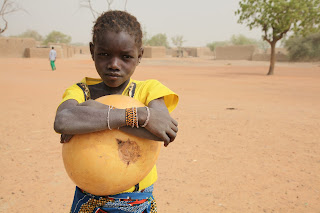"Hope and Resilience", Photo Exhibit from all actors across the Sahel
While the people in the Sahel are highly resilient, ever more frequent crisis have undermined their coping capacities to manage shocks.
The Photo Exhibition "Hope and Resilience" advocates for a more integrated humanitarian and development response to emergencies that goes beyond immediate life-saving and help build peoples´ resilience. The 18 photos have been taken by different actors working in the Sahel
Mali refugees take part in a traditiona
Seidou Sy Fame works long
hours in the community garden to tend crops threatened by drought. The
villagers living in Ganki are struggling to get by due to lack of rain
and rising food prices. CREDIT: Intermon Oxfam
Zenaib Daoud, age 25, lives in
Kassira village in the Guéra region of Chad. She is pictured carrying home food from Oxfam´s distributi

Participan
Burkina Faso / Damba refugee camp / Sixty-two years old Raichatou rests in her shelter while her grandsons and thirty-yea
Beneficiar
Soueba Garba and Abou Abdou listen as community outreach volunteer Karima Mani, 25, uses a flipbook to give them informatio
Danaya Diarra is growing and
selling vegetables from a WV vegetable garden. Life was difficult, battling to provide for her family and
now the food crisis is making matters worse. But life has improved since WV
taught Diango vegetable production
CREDIT: Worldvision
Children are playing in the Mopti area beside a ECHO supported nutritiona
Poor farmers are watering
their gardening with calabash. Improving access to small scale
irrigation increases production at household level and diversify source
of income. It increases resilience for the poorest. Credit ECHO/ Claire
Barrault
Women returning home with bags of improved millet and green bean seeds at an FAO distribution center in Niger. Protecting and reconstructing capacities is one of the key activities to build resilience, ensuring continued food production.CREDIT: Issouf Sanogo/ FAO
Abalak, Niger- FAO provides emergency assistance to small herders affected by the crisis to protect surviving livestock thus securing their livelihood assets. This is the first step to safeguard and strengthen their resilience CREDIT: Issouf Sanogo/ FAO
Forty-year
This old woman is an
internally displaced person in Koloma, a camp in Eastern Chad for people
who fled violent attacks from the Sudanese Janjaweed militia. Like many
other displaced people, she isn't just a victim or a beneficiar
A tree provides shelter from
the beating sun during a meeting between UN staff and returnees in
Borota, Eastern Chad. After a return to relative stability and peace in
the area, people left the camps for internally displaced people to come
home and rebuild their lives. This community now has less access to
clean water, healthcare
A child waits with his bowl
for millet outside the cereal bank in Niger. The millet is ground into
porridge once daily, which is the only meal for most families in
Tillaberi. Nevertheless, she has hope, goes to school and sees a future for herself CREDIT: Plan International
A teacher and students in a
classroom, Tillabéri, Niger. Classrooms are quiet these days as many
children have dropped out of school to help gather firewood and dung for
fuel, or have simply migrated to other places in search of food.
CREDIT: Plan Internatio
In Niger, WFP Food for Work projects are helping affected communitie














